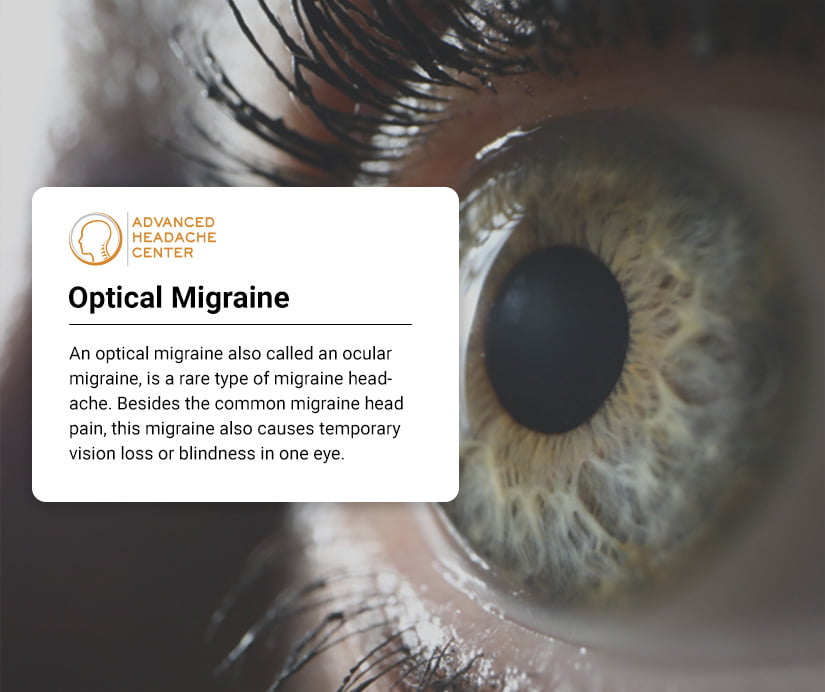Most migraine headaches cause aura phenomenon or changes to your visual acuity during a preliminary stage of the attack. Only optical migraines can cause actual, but temporary, blindness. It’s another debilitating symptom of these migraines in addition to the pain and nausea. Visit Dr. Amr Hosny at one of the eight Advanced Headache Center locations across New York City and northern New Jersey for complete care. The first step is an accurate diagnosis, followed by targeted treatment. Call Dr. Hosny today for a consultation.
What Is an Optical Migraine?
An optical migraine also called an ocular migraine, is a rare type of migraine headache. Besides the common migraine head pain, this migraine also causes temporary vision loss or blindness in one eye. These symptoms often ease after an hour during the migraine attack stage of your episode.
There are similarities between an ordinary migraine aura, a stage of more common migraines, and an optical migraine, but the differences include:
- Migraine auras affecting vision are much more common and rarely cause blindness. They accompany most migraines.
- A migraine aura that causes vision problems affects both of your eyes.
- Optical migraines only cause vision problems that affect one eye.
- Visual disturbances caused by migraine auras are of a shorter duration, usually lasting around 20 minutes or so.
- The vision problems in optical migraines last 30 minutes to an hour.
If you have a recurrent headache that lasts hours and affects your vision in one eye, schedules a consultation with Dr. Amr Hosny and the other pain specialists at the Advanced Headache Center. The team uses the latest medical equipment to reach a more precise migraine diagnosis, and they can treat you at one of their eight locations across Manhattan and Bergen County, New Jersey.

Am I Suffering from an Optical Migraine?
The most defining symptom of ocular migraines is the impact on your vision. When you add the loss of vision to the other symptoms of optical migraines, your life turns upside down, leaving you incapacitated.
Remember that the optical effects are temporary, but you may experience a range of visual disturbances with an optical migraine, including:
- Zig-zag patterns or lines in your vision
- Shimmering spots or stars
- Bright flashes of light that aren’t there
- A blind spot that migrates across your vision field
- Sparkles of lights, stars, or even blind spots in your vision
Migraines can be confusing because they sometimes seem to come out of nowhere, but most migraine episodes follow several stages that provide some warning if you know what to look for. What’s not in doubt is the debilitating impact this neurological condition has on your life. At the Advanced Headache Center, the focus is on achieving a correct diagnosis that helps Dr. Hosny create an individualized migraine treatment plan.
What Are the Causes and Triggers of Ocular Migraines?
Migraines likely occur due to abnormal electrical activity in the nervous system of your brain, causing faulty pain impulses to stimuli that are normally not painful. The abnormal activity spreads pain gradually across the brain. When this phenomenon affects the retina in the back of your eye, an ocular migraine develops.
There are a number of external stimuli that can trigger a migraine episode. They are all outside your brain, even though the migraine itself happens inside your brain.
Some of the factors that can trigger ocular migraines include:
- Harsh lights and electronic screens
- Driving long distances and other activities that tax your vision
- Loud noises
- Strong smells
- Genetics, if your family has a history of migraines
- Food additives, such as nitrates or monosodium glutamate (MSG)
- Environmental changes, such as weather or barometric pressure
- Hormonal changes in women
- Dehydration or hunger
- Too little or too much sleep
- Anxiety or stress
- Too much caffeine or alcohol
To reach an ocular migraine diagnosis, Dr. Hosny reviews your medical history, your family history, your migraine triggers, and the variety and severity of your other symptoms. Using these findings, your headache doctor creates a personalized treatment plan to address your pain, symptoms, and any underlying causes.
How Are My Optical Migraines Treated?
If you suffer serious visual disturbances during migraine attacks, this illness requires a prompt diagnosis. The incapacitating pain, temporary blindness, and other symptoms all affect your quality of life.
The doctors at the Advanced Headache Center use a multimodal approach to effectively treat all types of headaches, including optical migraines.
Your treatment may include:
- Migraine medications, including tricyclic antidepressants, non-steroidal anti-inflammatories (NSAIDs), and calcium channel blockers in rational polypharmacy approach
- Intravenous infusions, which deliver nutrients, painkillers, and anesthetics directly into your bloodstream
- Acupuncture, an alternative, but effective treatment
- Physical therapy, which finds exercises or stretches to ease your pain and other symptoms
- Chiropractic care, to keep your neck and shoulder bones in alignment
- Occipital nerve block, which deadens the occipital nerve, preventing it from sending pain signals to your brain
- Stellate ganglion block, to block pain signals from the stellate ganglion cluster of nerves
- Sphenopalatine ganglion block, blocking pain signals from the sphenopalatine ganglion
With an early diagnosis from the Advanced Headache Center, it’s possible to treat and manage optical migraine and its life-alerting symptoms. Dr. Hosny treats migraines to reduce visual disturbances and help you live a normal life. Contact the headache specialists today at the closest office in Midtown Manhattan or Paramus, NJ. Let the experts treat the incapacitating symptoms of your optical migraines.

Dr. Hosny is an Ivy League Trained, UCNS-accredited, board-certified headache specialist who offers the latest preventive and abortive treatments to provide safe and effective head pain relief. As an active member of prominent organizations and professional societies that advance headache science, education, and management, such as the National Headache Foundation, Dr. Hosney specializes in diagnosing and treating a wide range of head pain disorders, including tension headaches, migraines, and cluster headaches, to name a few.
Dr. Hosny's reputation for enhancing headache care quality through the use of the most effective and technologically advanced treatment options for persistent primary and secondary chronic headaches has been acknowledged by Castle Connolly and Healthgrades, where he has received over 200 positive reviews. Dr. Hosny is also recognized as a distinguished New York City physician and headache specialist by New York Magazine.
More about Dr. HosnyNew York, NY 10003
(646) 763-2222

